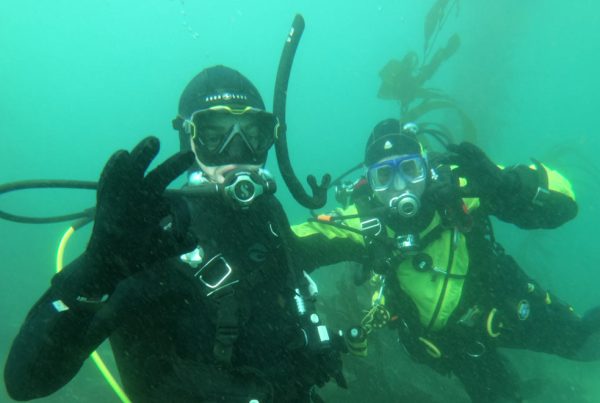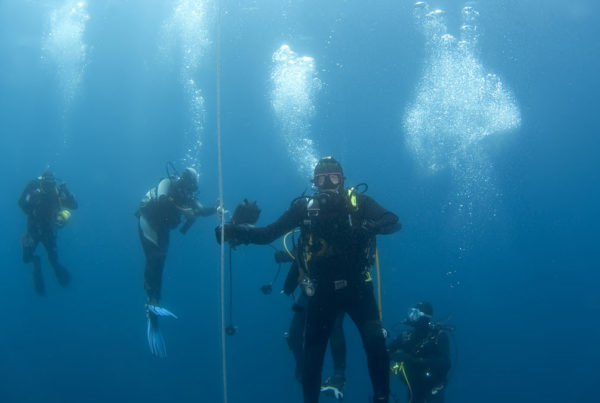California’s great beds of kelp are the single most important feature that makes diving here so interesting and unique. Throughout California kelp thrives on rocky reefs. In the north the predominant kelp is bull kelp, in the south it is giant kelp or Macrocystis. Both form the foundation for a healthy reef community and provide shelter and food for a cornucopia of marine life. In California the kelp bed is where most of the life is and where divers go. New divers sometimes have an unrealistic concern about entering a kelp forest, fearing that they may become entangled. Like most diving activities, safe practical kelp diving is all about planning and developing skills and level of comfort.
All of the potential hazards and obstacles that the ocean can throw at divers can be avoided with proper anticipation and planning. When planning your kelp dive, take into account that it is much easier to swim beneath or around a kelp bed than to crawl over it. Much of the density of kelp fronds is on the surface and not within the water column, so swimming beneath a kelp bed is more like navigating through a temple of Grecian pillars, rather than swimming through a plate of spaghetti.
The rule of thumb is divers should use one third of their air for the outbound portion of their dive, one third for the return, and one third for contingencies. You can rely on your compass or natural navigation aids to plan your dive and navigate back to your boat or shore entry point. If you mess up you always have air to spare. Should you lose track of your position, simply surface, get a new bearing and submerge.
If you need to deal with kelp directly, remember it has no malicious intentions and simply does what it does. Kelp is generally quite slippery and will not cling to and hold onto divers. If given a fair chance, it will slip off a diver and allow him or her to pass. Many new divers try to “chase” the kelp frond that catches on their BC or tank valve and swim in circles. This only makes matters worse—think of a fork in spaghetti. Instead, remain facing a constant direction and use one hand to lift the kelp away; or better yet, have your buddy help. Remember to “kelp proof” your gear by positioning straps, knives, and other diving tools so they do not function as kelp hooks.
When ascending through a thick layer of kelp, choose a thin portion, ascend slowly and make a hole in the kelp by pushing the kelp away with your hands. To descend, first push the kelp away from you and then descend by letting the air out of your BC and exhaling strongly to dip below the surface feet down without performing a surface dive. If you are too buoyant for this, then grab a kelp stipe and pull yourself beneath the canopy without kicking.
If possible, you should surface swim around a bed of kelp. Should the bed be particularly thin, it is possible to navigate through a kelp bed by avoiding one plant at a time. Should you be unlucky and find yourself out of air in the middle of a thick bed, you will have no choice but to crawl over it. And, crawling is what it’s all about. You should not attempt to use your fins to kick though a kelp bed; rather, keep your legs straight behind you and do not move them. Use both your arms in unison to first push the kelp down and then behind you. The downward motion gives you a bit of lift and enables you to skim over the top of the kelp as you push back.
This takes a bit of practice, so you might consider trying this technique before you really need to use it. Try jumping into a bed of kelp without your tank and BC and practice kelp crawling. Then put your equipment on and practice again with a buddy to help should you become entangled. If you are carrying equipment and do not have both hands free, it is possible to use one hand to hold your equipment on your shoulder and do the “one-handed kelp crawl” with the other.
As you gain experience in dealing with thick kelp you will also gain a comfort level and confidence in your ability to deal with whatever the kelp throws at you. After a short time you will become a proficient and comfortable kelp crawler. After all, for California divers it’s all about the kelp.










